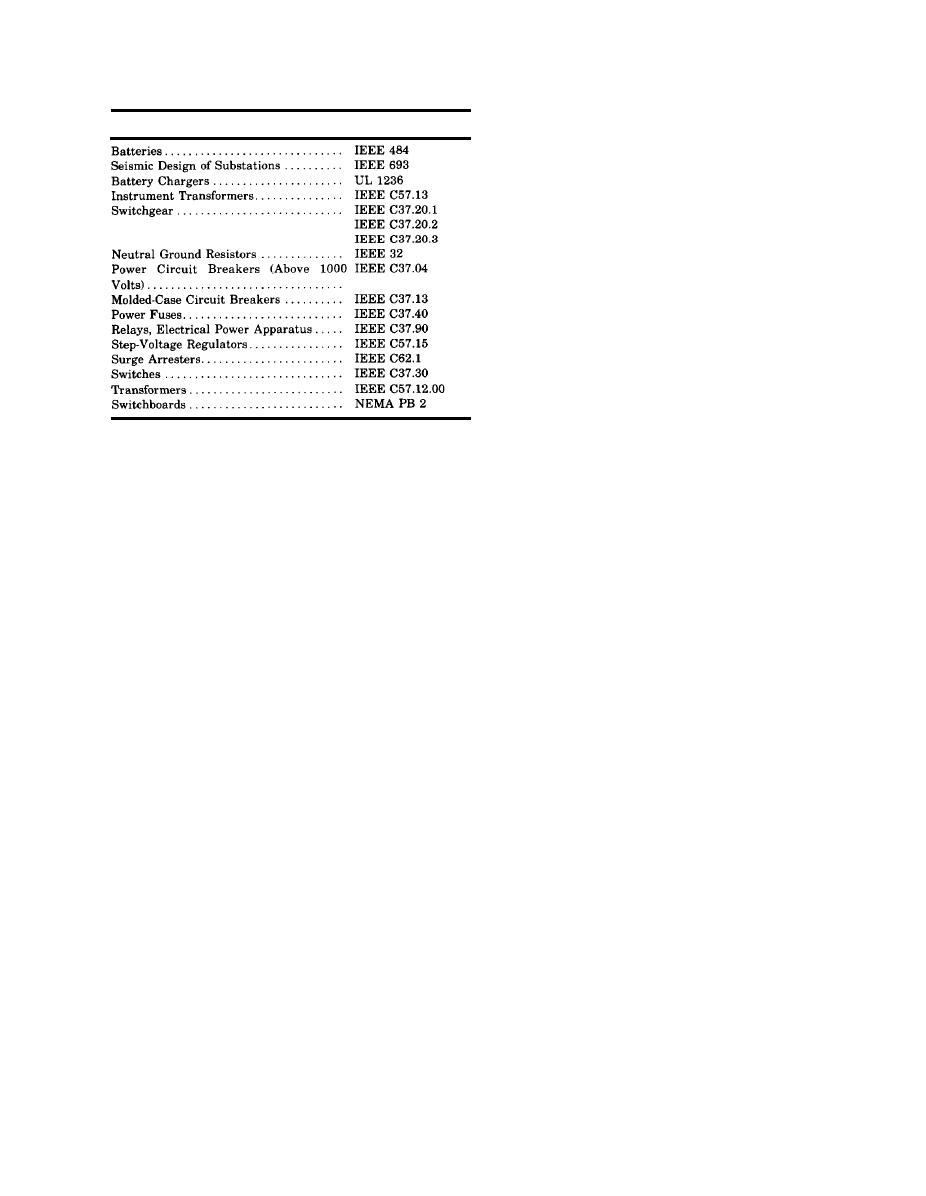
TM
5-811-1/AFJMAN
32-1080
fill interstices in the coils and preclude the entrap-
Table 1-1. Service Conditions.
ment of air or moisture. The sealer coat may also
Standard
Item of Equipment
be applied by brushing or spraying.
c. Corrosive or contaminated atmospheres. Up-
grading of equipment located in atmospheres
where corrosion occurs (because of excessive humid-
ity or from industry contamination which may be
intensified by fog) will be provided only where local
practice indicates the additional cost is justified.
(1) Upgrading corrosion resistance. Where a
better than standard coating is required, a salt
spray test will be specified for the finish. Length of
the testing period will be in accordance with
standard practice for the area.
(2) Insulating devices. Where over insulation
in contaminated areas is required, bushings will be
specified for the next higher basic impulse level
(BIL) than required for that device insulation class.
d. Insect and rodent damage. The applications
b. Tropic conditions. Basic engineering practices
listed below will be investigated and implemented,
governing design and construction of electrical
as required, in areas where insert and rodent
power systems in temperate areas will be applied
damage to underground cable installations is a
to tropic zones. Potential problems which may
problem. Proven local practice will also be followed.
result from corrosion and termite infestation, as
(1) Use armored cable.
well as the feasibility of using local materials, will
(2) Use cable with higher voltage rating.
be investigated in order to select the most suitable
(3) Use cable with full concentric neutral.
elements for the system. Outdoor switchgear will
(4) Install animal guards around existing con-
be enclosed and have space heaters with automatic
crete pads and around pipe entrances on wood
controls. In typhoon areas, design will provide
walls.
sufficient strength for the extreme wind loading
(5) On new installations, install buried fiber-
conditions encountered. Where fungus control is
glass pads that animals cannot penetrate.
required, the following paragraphs will be edited
(6) Specify cable with rodent protection armor.
and included as a part of the project specifications
(7) Specify seals or cover all crevices greater
as required:
t h a n -inch.
( 1 ) Contact surfaces of devices such as
(8) Select foundation area plantings which do
switches, fuses, and circuit breakers need not be
not compliment local area pest habitats.
treated. Other materials and components which
(9) Do not use toxic chemical treatment of the
are inherently fungus-resistant or are protected by
soil.
hermetic sealing need not be treated.
e. Seismic design. The seismic design of electri-
(2) Circuit elements, not covered in above
cal installations will comply with agency criteria;
paragraph and which have a temperature rise of
TM 5-809-10; and AFM 88-3, Chapter 13. The
not more than 75 degrees F when operating at full
seismic design of electric substations will comply
load shall be treated in accordance with
with IEEE 693.
MIL-T-152. Circuit elements include, but are not
f. Electromagnetic pulse (EMP) and high-altitude
limited to, cable, wire, terminals, switchgear, pa-
electromagnetic pulse (HEMP). EMP and HEMP
nelboards, capacitors, and coils.
requirements will be in accordance with MIL STD
(3) Circuit elements, such as motor coils, dry-
188-125 and MIL HDBK 423.
type transformers, and similar electrical compo-
g. Environmental compliance. The design will
nents, which have a temperature rise exceeding 75
provide electrical systems which comply with Fed-
degrees F when operating at full load shall not be
eral, state, and local environmental regulations.
coated with a fungitoxic compound. Instead, such
Transformer dielectric information in chapter 8
components shall be given two coats of varnish
will be applied to all dielectric-filled equipment.
and one sealer coat, both conforming to Type M,
1-11. Explanation of Abbreviations and Terms.
Class 130 of MIL-I-24092. Coats shall be applied
by the vacuum-pressure, immersion, centrifugal,
Abbreviations and terms used in this manual are
pulsating-pressure, or the built-in method so as to
explained in the glossary.
1-6



 Previous Page
Previous Page
